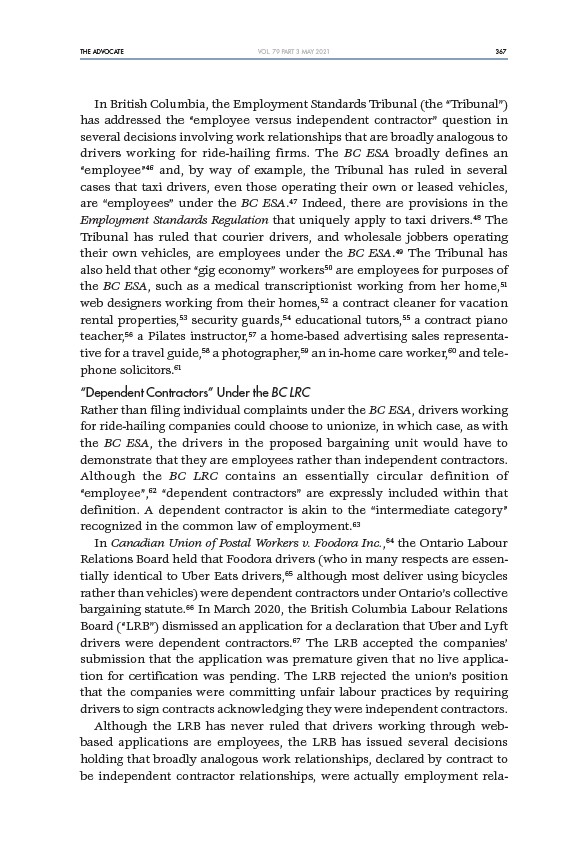
THE ADVOCATE 367
VOL. 79 PART 3 MAY 2021
In British Columbia, the Employment Standards Tribunal (the “Tribunal”)
has addressed the “employee versus independent contractor” question in
several decisions involving work relationships that are broadly analogous to
drivers working for ride-hailing firms. The BC ESA broadly defines an
“employee”46 and, by way of example, the Tribunal has ruled in several
cases that taxi drivers, even those operating their own or leased vehicles,
are “employees” under the BC ESA.47 Indeed, there are provisions in the
Employment Standards Regulation that uniquely apply to taxi drivers.48 The
Tribunal has ruled that courier drivers, and wholesale jobbers operating
their own vehicles, are employees under the BC ESA.49 The Tribunal has
also held that other “gig economy” workers50 are employees for purposes of
the BC ESA, such as a medical transcriptionist working from her home,51
web designers working from their homes,52 a contract cleaner for vacation
rental properties,53 security guards,54 educational tutors,55 a contract piano
teacher,56 a Pilates instructor,57 a home-based advertising sales representative
for a travel guide,58 a photographer,59 an in-home care worker,60 and telephone
solicitors.61
“Dependent Contractors” Under the BC LRC
Rather than filing individual complaints under the BC ESA, drivers working
for ride-hailing companies could choose to unionize, in which case, as with
the BC ESA, the drivers in the proposed bargaining unit would have to
demonstrate that they are employees rather than independent contractors.
Although the BC LRC contains an essentially circular definition of
“employee”,62 “dependent contractors” are expressly included within that
definition. A dependent contractor is akin to the “intermediate category”
recognized in the common law of employment.63
In Canadian Union of Postal Workers v. Foodora Inc.,64 the Ontario Labour
Relations Board held that Foodora drivers (who in many respects are essentially
identical to Uber Eats drivers,65 although most deliver using bicycles
rather than vehicles) were dependent contractors under Ontario’s collective
bargaining statute.66 In March 2020, the British Columbia Labour Relations
Board (“LRB”) dismissed an application for a declaration that Uber and Lyft
drivers were dependent contractors.67 The LRB accepted the companies’
submission that the application was premature given that no live application
for certification was pending. The LRB rejected the union’s position
that the companies were committing unfair labour practices by requiring
drivers to sign contracts acknowledging they were independent contractors.
Although the LRB has never ruled that drivers working through webbased
applications are employees, the LRB has issued several decisions
holding that broadly analogous work relationships, declared by contract to
be independent contractor relationships, were actually employment rela-